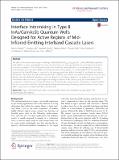Interface intermixing in type II InAs/GaInAsSb quantum wells designed for active regions of mid-infrared-emitting interband cascade lasers
Abstract
The effect of interface intermixing in W-design GaSb/AlSb/InAs/Ga0.665 In0.335 AsxSb1 − x/InAs/AlSb/GaSb quantum wells (QWs) has been investigated by means of optical spectroscopy supported by structural data and by band structure calculations. The fundamental optical transition has been detected at room temperature through photoluminescence and photoreflectance measurements and appeared to be blueshifted with increasing As content of the GaInAsSb layer, in contrast to the energy-gap-driven shifts calculated for an ideally rectangular QW profile. The arsenic incorporation into the hole-confining layer affects the material and optical structure also altering the InAs/GaInAsSb interfaces and their degree of intermixing. Based on the analysis of cross-sectional transmission electron microscopy images and energy-dispersive X-ray spectroscopy, we could deduce the composition distribution across the QW layers and hence simulate more realistic confinement potential profiles. For such smoothed interfaces that indicate As-enhanced intermixing, the energy level calculations have been able to reproduce the experimentally obtained trend.
Citation
Motyka , M , SęK , G , Ryczko , K , Dyksik , M , Weih , R , Patriarche , G , Misiewicz , J , Kamp , M & Höfling , S 2015 , ' Interface intermixing in type II InAs/GaInAsSb quantum wells designed for active regions of mid-infrared-emitting interband cascade lasers ' , Nanoscale research letters , vol. 10 , no. 471 . https://doi.org/10.1186/s11671-015-1183-x
Publication
Nanoscale research letters
Status
Peer reviewed
ISSN
1931-7573Type
Journal article
Description
The work has been supported by Project Widelase (no. 318798) of the Seventh Framework Programme of the European Commission.Collections
Items in the St Andrews Research Repository are protected by copyright, with all rights reserved, unless otherwise indicated.

